What is Steel Wool Photography?
Steel Wool Photography is the process of using long camera exposures to capture the motion of hot sparks flying through the air through the act of spinning burning steel wool. These sparks are very hot and glow brightly as they fly through the air. As they fly away from the spinner, the camera sensor captures the streaks of light created. This type of photography is unique and fun. 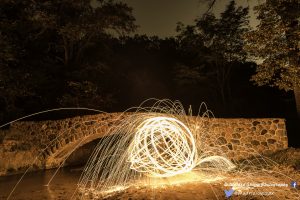
Safety First
Steel wool photography can be very dangerous. It involves working with fire. You’ll be spinning extremely hot pieces of burning metal with sparks traveling in all directions. This metal can burn you or start fires if you’re not careful. So please, follow these safety tips to keep yourself, others and the environment safe:
- Wear proper protective clothing:
- Cover your skin and wear long sleeve clothing made from natural fibers. Synthetics such as nylon can catch fire easily.
- A hood or hat to cover your hair.
- Eye protection.
- Choose a location without flammable materials nearby. For example, grass, trees, or wooden buildings can all easily catch fire from the hot sparks. Never do steel wool photography indoors. Ideal locations include beaches, rocky/sandy deserts, or large parking lots with no nearby vehicles/buildings. The sparks from spinning the wool can travel a long distance from where you are standing, depending on how fast you spin, so make sure you have plenty of space between you and the nearest flammable material.
- Choose a time when the weather and location are wet. Shooting after a rainfall is ideal, or early in the morning when there is still dew on the ground. Winter shooting on the snow or ice can also be a fun experience.
- Bring a fire extinguisher. Even if you are shooting in a location with no flammable materials, and shooting at a time when the environment is wet, surprises can happen. Be prepared by having a fire extinguisher nearby.
- Do a site walk after you are finished, looking for any hot spots, burning embers, and/or smoke. Carefully survey the area to be 100% sure that nothing is burning after you finish up. A single hot ember can smolder for some time before finally igniting and causing a fire after you are gone. If you do come across any burning embers or hot spots, extinguish them with some water, sand, or your fire extinguisher before leaving the site.
- Keep people, children, and pets a safe distance from the location. Better yet leave the pets and children at home.
- Never do steel wool photography in or near old wooden historic structures. Old abandoned houses, boats, and other historic sites might seem like a cool place to capture a creative steel wool photo. But there have been a number of occasions in the past where these structures have caught fire because of photographers using steel wool. Old wooden buildings and structures are extremely high risk to catch fire as the wood is often very dry, old paints are flammable and they are likely covered in oils, soot, or other flammable chemicals. Please use common sense and do not attempt steel wool photography near these types of structures. You risk a large fire, destroying a piece of history, a large fine/jail time, and giving photographers a bad reputation.
Steel wool photography is a risky endeavor. By partaking in this activity, you do so at your own risk and I and/or Willard Sharp Photography are not responsible or liable for any injury or damage caused.
What do I Need to Create Steel Wool Photos?
In addition to the above-mentioned safety equipment you’ll need the following supplies to create these types of photos: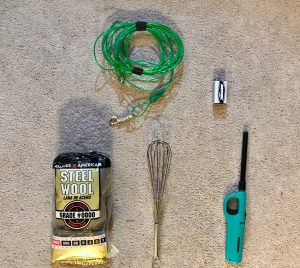
- Steel wool. Steel wool comes in a variety of grades ranging from 0000 to 4. The smaller the number the finer the grade of wool. For the best photos, you want very fine grade steel wool. Ideally either 0000 or 000. Grade 1 and higher will not work.
- A metal whisk, with a loop at the end to attach a rope or chain. Choose a metal one because the silicone ones will melt quickly. Also, don’t bring the whisk you plan to use for breakfast the next day. Steel wool spinning will likely destroy the whisk so pick up a cheap one from a local discount store.
- Rope or chain to attach to the whisk. I use a cheap dog leash as they are easy to attach.
- Something to light the fire with. A lighter works great. You can also use a 9V battery. Just touch the battery against the wool to light it. If you use a lighter, keep in mind it may not work well if you’re spinning steel wool in very cold temperatures. And keep in mind that you cannot store the steel wool with the 9V battery in case of accidental contact with one another.
- A camera that you can shoot in manual mode, and a tripod. You will be shooting in long exposures so knowing how to use the camera’s manual mode will be required, as well as a tripod to keep the camera steady during the exposure.
- Use a cable release or remote trigger to trigger the shutter on the camera. If you don’t have these then you can set your camera to continuous shooting to capture your steel wool spin.
- If you don’t want to see the person in the shot, have them wear black to conceal them better.
Those are the basics of what you’ll need. Also, having a friend to spin the wool while you shoot, or taking turns, so you can each spin/shoot can make it easier. But if it is just yourself you can do it by setting the camera’s self-timer, interval mode, or shooting continuous with the cable release button held down.
How to Take Steel Wool Photographs
- Attach the whisk to the rope or dog leash keeping the length to around 2 ft.
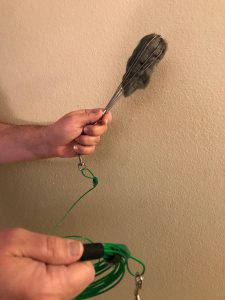
- Take a piece of steel wool out of the package. Open it up and fluff the steel wool a little bit. Fluffing will allow for better air flow through the steel wool and give you a more consistent burn.
- Stuff the steel wool inside the head of the whisk. Don’t pack it in too tight as air will have to flow through it for it to burn effectively.
- Light the wool using the lighter or battery. You don’t need the wool to be on fire, just a few parts to be glowing. As you spin, the air moving through the steel wool will ignite and cause the sparks to fly.
- Holding the other end of the rope or dog leash, spin the wool in a circle, causing the sparks to fly from the end of the whisk.
- As the person starts spinning, press the shutter button on the camera to capture the image.
Helpful hint: You should practice spinning the whisk on the rope or leash a few times before attempting it with the burning steel wool. Especially, practice stopping the spin slowly without hitting yourself with the whisk. This may sound trivial, but if the whisk hits you while you are trying to stop it you’ll get burned. It gets extremely hot during the process. I also like to keep a bucket of water nearby, if I’m not near a lake or stream, to dip the whisk in after and cool any remaining hot wool before refilling it with more steel wool.
What Camera Settings Should You Use?
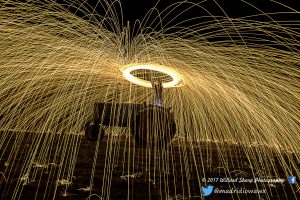
Shutter 20 seconds, aperture f/6.3, ISO 200
As mentioned above you will want to set your camera in manual mode to capture the long exposure. Because of this, the best time of day to do steel wool photography is twilight to dark. Blue hour is one of my favorite times for steel wool photography as you get interesting sky colors and some light to expose objects near you.
Shutter speed: You want to capture enough of the movement to show the streaking lights caused by the flying sparks. Generally I shoot at exposures between 5 and 20 seconds.
Aperture: Ideally you want to choose an aperture where you have a good depth of field to keep background objects looking sharp. I like to shoot between f/6.3 and f/11. The further away you are from the spinner and sparks, you many need to open the aperture up to allow for more light in.
ISO: Keeping your ISO low will keep you from blowing out the brightness of the steel wool when it is lit. I usually shoot at ISO 100 or 200. If you’re further back you may want to bump that ISO up to 400 or higher if needed.
The settings I normally use are 20 seconds, f/8, and ISO 200.
Expose for the foreground, sparks or both?
There are a few ways to do this depending on the available light. If it’s twilight or a full moon in the sky, or you have other ambient light sources 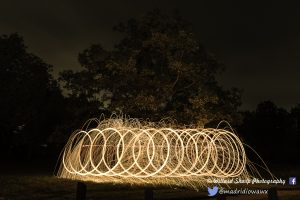 nearby you can expose for the sparks and the surrounding environment at the same time. In very dark locations, you’ll want to capture the environment using a longer exposure, wider aperture, or higher ISO before or after shooting the steel wool and then blend the two in post processing. There is no right or wrong way to do this; it just depends on your vision for the photo and your post processing skills.
nearby you can expose for the sparks and the surrounding environment at the same time. In very dark locations, you’ll want to capture the environment using a longer exposure, wider aperture, or higher ISO before or after shooting the steel wool and then blend the two in post processing. There is no right or wrong way to do this; it just depends on your vision for the photo and your post processing skills.
What Focal Length is best?
The lens choice and focal length when shooting steel wool can make a difference to the look and feel of the final image, but you also want to choose a focal length that keeps the camera a safe distance from the sparks. I prefer a wide angle lens when shooting steel wool photography. 20 to 35mm works well for the vast majority of steel wool shoots.
Focusing
As you will be leaving the camera on the tripod and shooting in low light, you should manual focus on the spot you will be standing while spinning. I generally shine a flashlight on the spot I will be standing and then manual focus using live view. Also, if your lens has image stabilization or vibration reduction then remember to turn it off when shooting on a tripod. One final camera tip is to turn off long exposure noise reduction.
Post-Processing Steel Wool Photography
Post processing photography is a very subjective process. We each have a vision for how we want our images to look. So I won’t spend a great deal of time on this topic. But there are a few things to know when processing steel wool photographs. If you kept your ISO low and didn’t blow out the exposure of the highlights then you have a lot of options you can do to change the look of the image, particularity in the highlights/shadows and color balance. Adjusting those sliders can drastically change the look of the streaks, so take some time to play around with those sliders in your post processing software to decide what look works best for you. I generally drop my highlights about 50-75% for most of my steel wool photographs.
Get Creative
There’re several ways you can get creative with steel wool photos to make them even more interesting.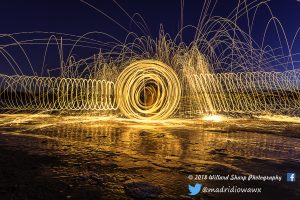
- Spin in different ways: Spinning over your head, horizontal, figure-eight patterns can all make varying looks to the images and send the sparks flying out in different directions for cool new images.
- Zoom in or out during the exposure to create cool spirals.
- Walk forward, backward, or from side to side to create loops ad tunnels.
- Including additional light painting aspects into a photo with steel wool can make the images pop even more. Try taping glow sticks to the handle of the whisk or rope, using gels and off camera flash, or light painting the foreground with a flashlight to create different effects.
- Introduce props or people. Adding a prop, such as a person holding a wet umbrella to block the sparks, can be a fun and creative way to compose these shots. But keep in mind the safety tips above when adding in other aspects. Be safe and don’t use flammable materials.
Summary
Steel wool photography is a fun and interesting way to be creative with your photography. I enjoy heading out during the late evening or overnight hours with my steel wool and camera in tow to see what kind of unique and interesting photos I can create.
Remember to be safe and use common sense. You’re working with fire, so there are risks involved and nobody wants to see any property damaged or destroyed. Be safe and be creative!
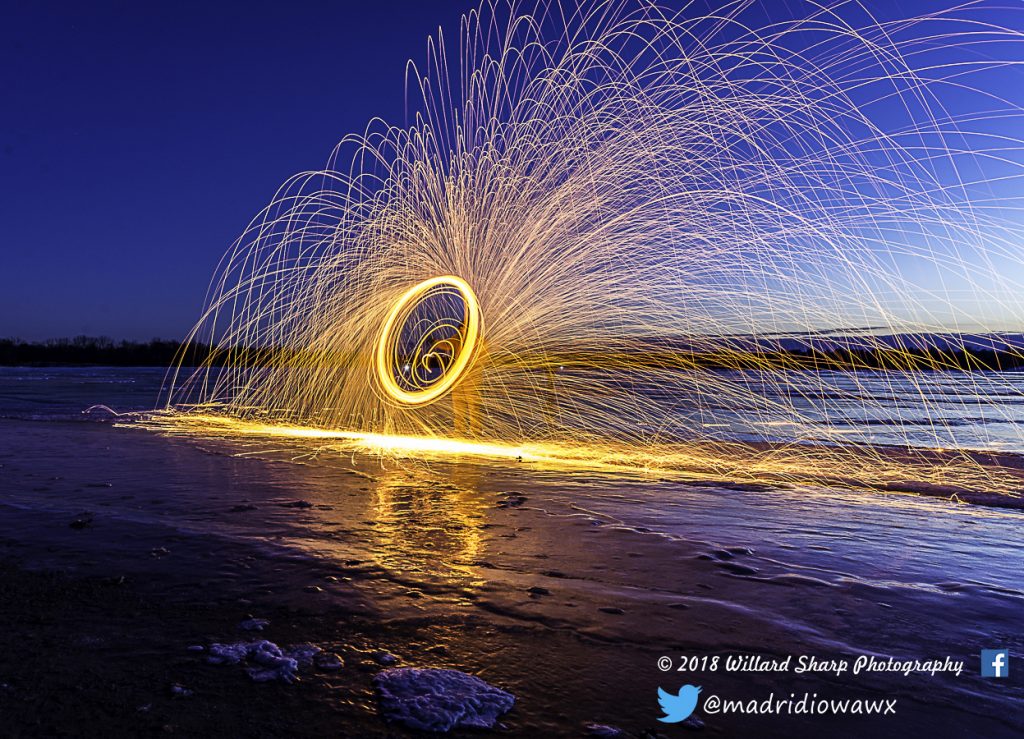
One Comment
Thank you for a well done synopsis covering steel wool fire photography! I was under the weather and couldn’t make the event last weekend! Drat!! I hope I can get into another event doing this before the snow melts ! Thank you!!!